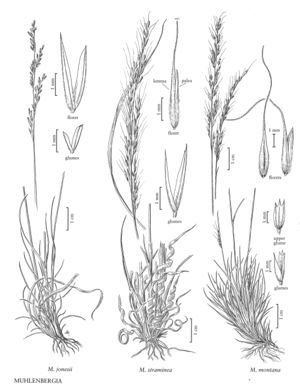Difference between revisions of "Muhlenbergia straminea"
FNA>Volume Importer |
imported>Volume Importer |
||
| (8 intermediate revisions by 2 users not shown) | |||
| Line 17: | Line 17: | ||
-->{{Treatment/Body | -->{{Treatment/Body | ||
|distribution=Ariz.;N.Mex. | |distribution=Ariz.;N.Mex. | ||
| − | |discussion=<p>Muhlenbergia straminea grows on rolling, rocky slopes, volcanic tuffs, canyon bottoms, and ridges, usually in open pine forests, at elevations of 1800-2600 m. It is known only from the southwestern United States.</p> | + | |discussion=<p><i>Muhlenbergia straminea</i> grows on rolling, rocky slopes, volcanic tuffs, canyon bottoms, and ridges, usually in open pine forests, at elevations of 1800-2600 m. It is known only from the southwestern United States.</p> |
|tables= | |tables= | ||
|references= | |references= | ||
| Line 26: | Line 26: | ||
-->{{#Taxon: | -->{{#Taxon: | ||
name=Muhlenbergia straminea | name=Muhlenbergia straminea | ||
| − | |||
|authority=Hitchc. | |authority=Hitchc. | ||
|rank=species | |rank=species | ||
| Line 33: | Line 32: | ||
|basionyms= | |basionyms= | ||
|family=Poaceae | |family=Poaceae | ||
| + | |illustrator=Linda A. Vorobik;Annaliese Miller | ||
| + | |illustration copyright=Utah State University | ||
|distribution=Ariz.;N.Mex. | |distribution=Ariz.;N.Mex. | ||
|reference=None | |reference=None | ||
| Line 38: | Line 39: | ||
|publication year= | |publication year= | ||
|special status= | |special status= | ||
| − | |source xml=https:// | + | |source xml=https://bitbucket.org/aafc-mbb/fna-data-curation/src/200273ad09963decb8fc72550212de541d86569d/coarse_grained_fna_xml/V25/V25_759.xml |
|subfamily=Poaceae subfam. Chloridoideae | |subfamily=Poaceae subfam. Chloridoideae | ||
|tribe=Poaceae tribe Cynodonteae | |tribe=Poaceae tribe Cynodonteae | ||
Latest revision as of 18:58, 11 May 2021
Plants perennial; cespitose. Culms 25-70 cm, erect, rounded near the base; internodes glabrous. Sheaths glabrous, stiff, becoming flattened, ribbonlike or papery, and conspicuously spirally coiled when old; ligules (6)10-20 mm, hyaline, acuminate, lacerate; blades 7-25 cm long, 1-4 mm wide, flat to involute, scabrous abaxially, spiculate adaxially. Panicles 8-25 cm long, 0.5-3 cm wide, not dense; primary branches 0.6-8 cm, appressed or diverging up to 30° from the rachises; pedicels 0.2-5 mm, scabrous. Spikelets 3.5-7 mm, yellowish to pale greenish. Glumes (3)3.5-6(7) mm, scabridulous, unawned or awn-tipped; lower glumes shorter than the upper glumes, 1-veined; upper glumes equaling or exceeding the florets, 3-veined, acuminate to acute, occasionally 3-toothed, awned, awns to 1.5 mm; lemmas 3.5-5.5(6) mm, lanceolate, pubescent on the lower 1/2 of the midveins and margins, hairs to 1 mm, apices scabrous, acuminate, awned, awns 12-27 mm, flexuous; paleas 3.5-5.5 mm, lanceolate, pilose between the veins, apices scabridulous, acuminate; anthers 2-3.5 mm, purple. Caryopses 1.9-2 mm, fusiform, light brown. 2n = unknown.
Discussion
Muhlenbergia straminea grows on rolling, rocky slopes, volcanic tuffs, canyon bottoms, and ridges, usually in open pine forests, at elevations of 1800-2600 m. It is known only from the southwestern United States.
Selected References
None.
